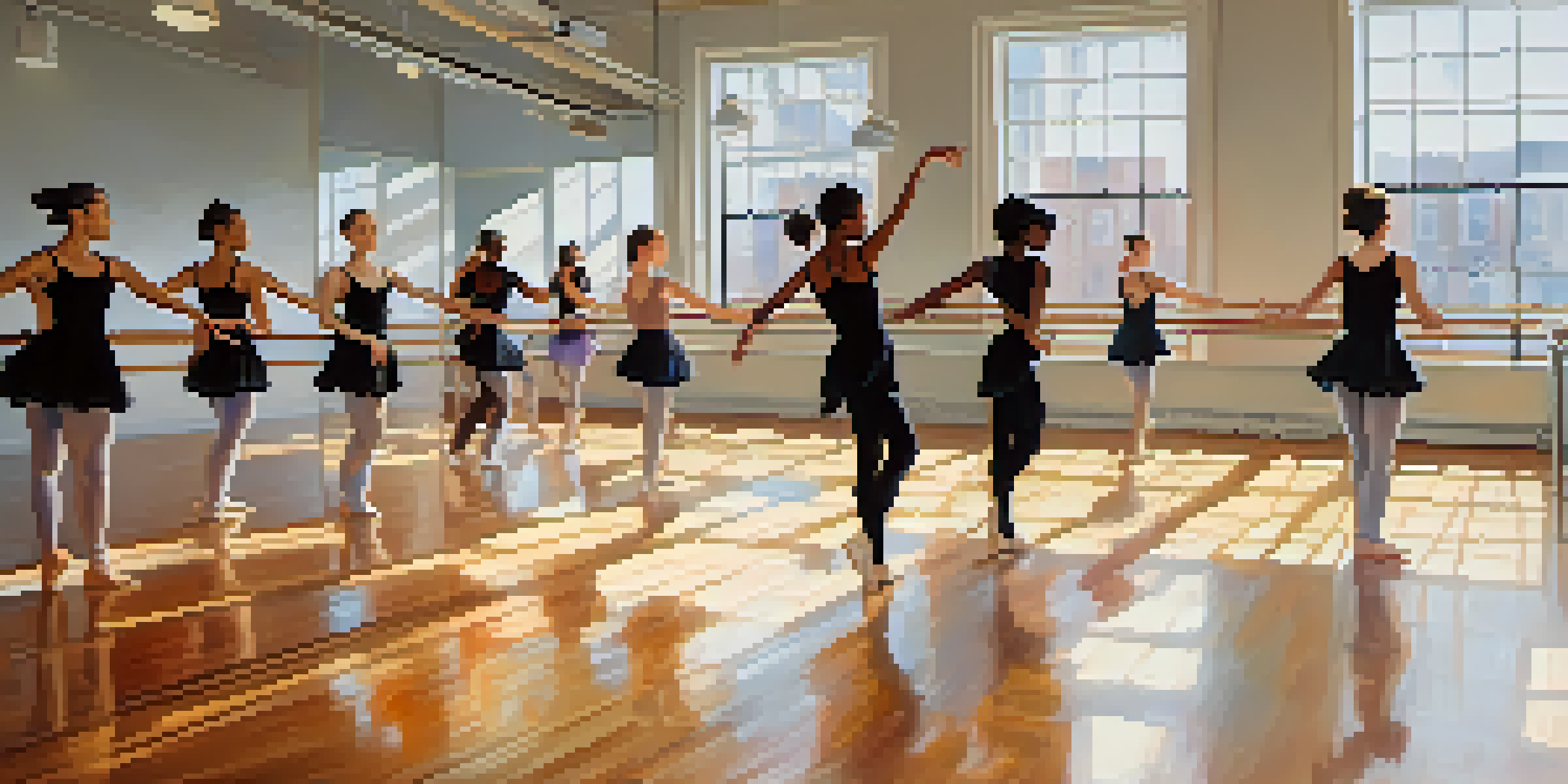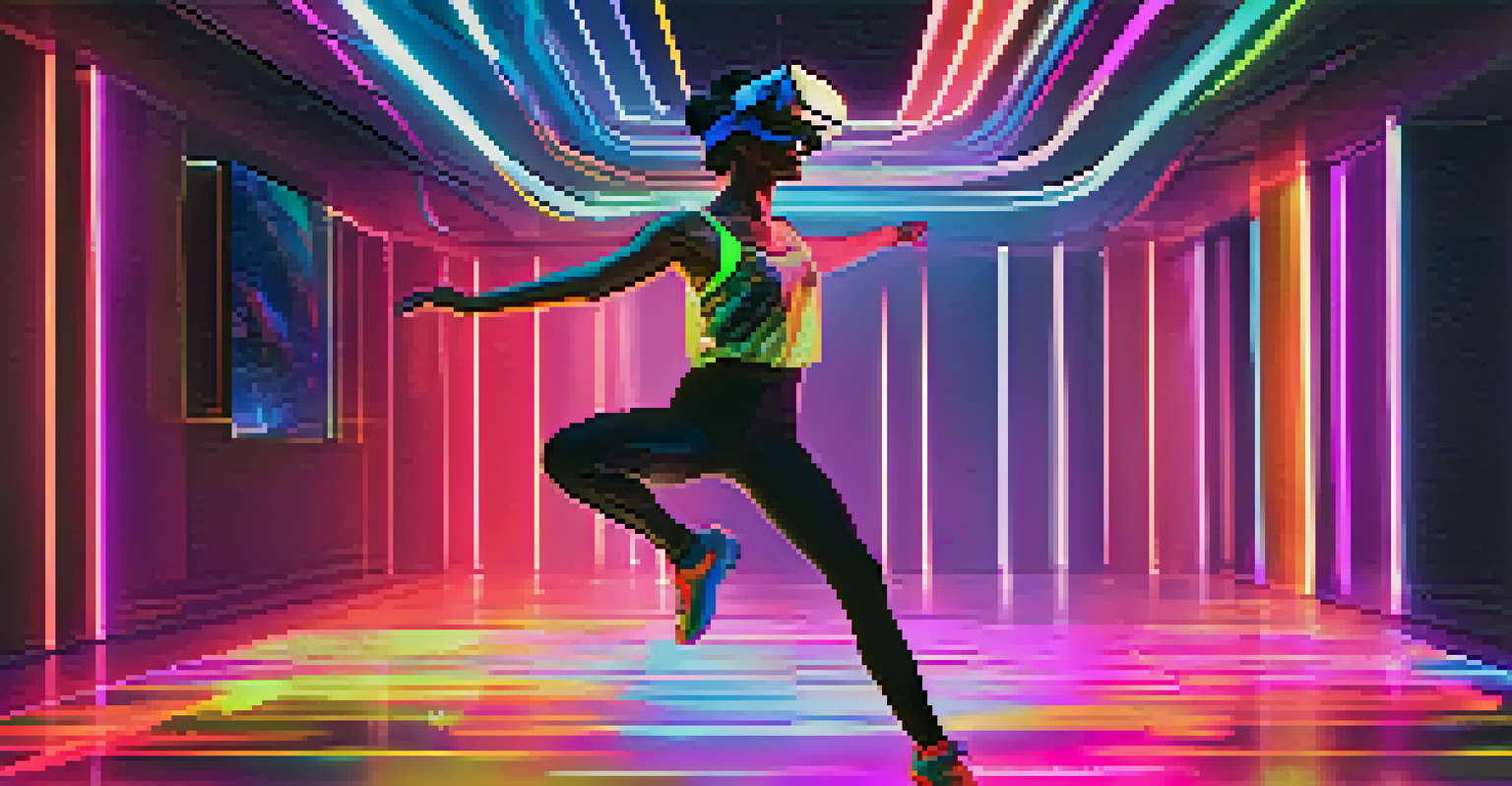The Influence of Technology on Global Dance Practices

The Rise of Digital Platforms in Dance Communities
In recent years, digital platforms have revolutionized how dancers connect and share their craft. Social media sites like Instagram and TikTok allow dancers to showcase their skills to a global audience, breaking geographical barriers. This online exposure not only fosters talent but also creates diverse communities that thrive on collaboration and inspiration.
Dance is the hidden language of the soul.
Moreover, these platforms have birthed viral dance challenges, encouraging participation from amateurs and professionals alike. For instance, the 'Savage Love' dance challenge pulled millions into the world of dance, proving that anyone can join in the fun. This democratization of dance has made it accessible and relatable, allowing for a blend of styles and cultures.
However, while the digital landscape promotes inclusivity, it also raises questions about authenticity and originality. As dancers mimic popular trends, the fine line between inspiration and imitation becomes blurred, prompting discussions about artistic integrity in this digital age.
Virtual Reality: A New Dimension in Dance
Virtual reality (VR) is carving out an exciting niche in the dance world, providing immersive experiences that were previously unimaginable. Dancers can now practice in virtual studios or perform in front of virtual audiences, enhancing their skills without the limitations of physical space. This technology opens up opportunities for training and performances that can reach audiences worldwide.

Imagine a dancer in New York collaborating with a choreographer in Tokyo, all while practicing in their own living rooms. VR makes this possible, allowing for real-time feedback and interaction that fosters creativity and innovation. These experiences can make dance more engaging and encourage participants to step outside their comfort zones.
Digital Platforms Transform Dance
Social media and apps have revolutionized how dancers connect, learn, and share their craft globally.
Yet, as with any technology, there are challenges to consider. The cost of VR equipment might be prohibitive for some, and while it enhances learning, it cannot replace the genuine connection of live performances. Balancing technology with traditional practices will be crucial in ensuring the art form remains vibrant and accessible.
Online Tutorials and Dance Education Evolution
The traditional dance class has evolved dramatically due to the availability of online tutorials and courses. Platforms like YouTube and specialized dance websites provide a wealth of resources, making high-quality instruction accessible to anyone with an internet connection. This shift allows aspiring dancers to learn at their own pace, regardless of their geographical location.
Technology is best when it brings people together.
These online resources cater to various skill levels, from beginners to advanced dancers, and cover a myriad of styles, from ballet to hip-hop. For instance, someone in a remote area can now learn contemporary dance from a renowned instructor without the need to travel. This accessibility promotes diversity in dance styles and techniques as more people are encouraged to explore different forms.
However, the abundance of information also raises concerns about quality control. With so many instructors sharing content, it's essential for learners to discern credible sources from less reliable ones. Fostering a critical approach to online learning will be vital in ensuring that dancers receive the best education possible.
The Influence of Dance Apps on Learning and Sharing
Dance apps are rapidly becoming a go-to resource for dancers seeking to enhance their skills and connect with others. These applications offer a variety of features, from instructional videos to community forums, creating a comprehensive platform for dancers of all levels. For instance, apps like Just Dance provide interactive ways to learn choreography while tracking progress.
Additionally, these apps foster a sense of community, allowing users to share their dance journeys, challenges, and achievements. This sense of belonging can be incredibly motivating, encouraging individuals to stay committed to their dance practice. The gamification of dance through these apps adds an element of fun, making learning enjoyable.
VR Enhances Dance Training Experience
Virtual reality offers immersive training and collaboration opportunities that transcend physical limitations.
On the flip side, reliance on apps can sometimes lead to isolation. While technology promotes connection, it can also create a barrier to face-to-face interactions. Striking a balance between virtual and in-person experiences will be essential to cultivate a well-rounded dance practice.
Social Media Trends Shaping Dance Styles
Social media is not just a platform for sharing dance; it's also a powerful influencer of dance trends and styles. With the rapid dissemination of content, new styles can gain popularity overnight, reshaping the dance landscape. Dancers often find themselves adapting to these trends, incorporating viral moves into their routines, which keeps the art form fresh and dynamic.
For instance, the influence of street dance styles from various cultures can now be seen in mainstream performances, thanks to platforms like TikTok. This cross-pollination of styles enriches the dance community, allowing for greater creativity and innovation. As trends evolve, dancers are continuously inspired by a blend of traditional and contemporary influences.
However, this constant change can also lead to pressure, as dancers may feel compelled to keep up with the latest trends. Striking a balance between personal expression and social media influence is vital for maintaining authenticity in one's dance journey.
The Role of Streaming Services in Dance Performance
Streaming services have transformed how dance performances are consumed, allowing audiences to experience shows from the comfort of their homes. Platforms like Netflix and YouTube offer a variety of dance performances, ranging from classical ballets to innovative contemporary pieces. This accessibility has broadened the audience base, introducing dance to those who may never have attended a live performance.
Moreover, streaming has provided opportunities for choreographers and dancers to showcase their work on a global stage. Artists can now reach wider audiences, increasing their visibility and potential for collaboration. This new avenue for sharing performances can also lead to increased funding and support for dance projects.
Streaming Expands Dance Audiences
Streaming services allow audiences to enjoy diverse dance performances from home, broadening the art form's reach.
However, there are concerns regarding the future of live performances. While streaming offers convenience, it cannot replicate the energy and connection of a live audience. As the dance world navigates this new landscape, finding ways to merge both streaming and live experiences will be essential for the art form's sustainability.
The Future of Dance in the Age of Technology
As technology continues to advance, the future of dance is poised for exciting developments. Innovations in artificial intelligence and machine learning may lead to new forms of choreography, with algorithms analyzing movement patterns and suggesting new sequences. This could challenge traditional notions of creativity, pushing dancers to explore uncharted territories in their art.
Furthermore, the integration of technology in dance performances, such as interactive elements and augmented reality, could enhance the audience experience, making each show unique and engaging. As audiences become more tech-savvy, the demand for innovative performances will likely grow, prompting artists to think outside the box.

However, it's essential to approach these advancements thoughtfully. While embracing technology can enhance the art of dance, preserving its emotional and cultural essence remains paramount. Striking a balance between innovation and tradition will be crucial to ensure that dance continues to resonate with audiences for generations to come.